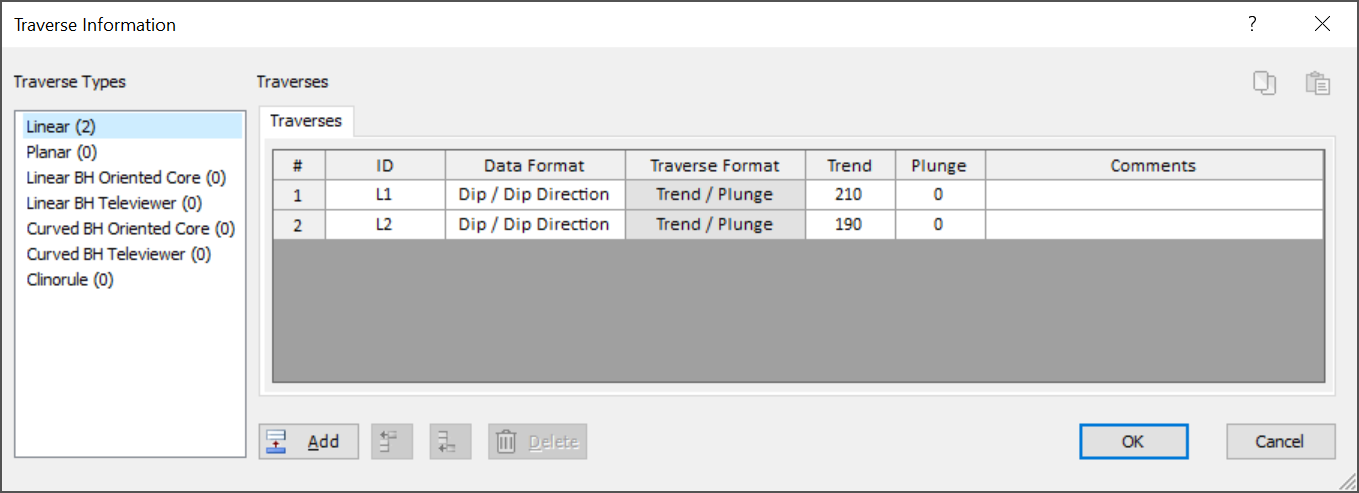Linear
A Linear Traverse Type can be any type of linear scanline on which planar orientation data is collected along a straight line with constant trend / plunge (e.g., scanline, tunnel wall mapping, or processed borehole).
Traverse ID
For a Linear Traverse, the default Traverse ID will have an "L" prefix (e.g., L1, L2, ...) when you initially add/create Traverses. After adding Traverses you can change the default ID values to any numeric or alpha-numeric values.
Data Format
The Data Format refers to the orientation format of the data collected on a Traverse. For each Linear Traverse, the orientation format of the data you enter in the first two columns of the Dips Grid Data view, must correspond to the Data Format selected in the Traverse Information dialog.
The following Data Formats are available:
- Dip/DipDirection
- Strike(Right)/Dip
- Strike(Left)/Dip
- Trend/Plunge
The Data Format option allows you to specify the orientation format for individual Traverses. This allows you to combine different data formats within the same Dips file. By default, the Data Format for a Linear Traverse is the same as the Global Orientation Format (entered in Project Settings).
If the Data Format (for a Traverse) is different from the Global Orientation Format (entered in Project Settings), the Data Format in the Traverse Information dialog will override the Global Orientation Format. See the Data Format / Traverse Format topic for more information.
Traverse Format
The Traverse Format refers to the orientation format used to define the orientation of the Traverse itself. For a Linear Traverse, the Traverse Format is always Trend / Plunge, regardless of the Data Format.
Example of Traverse Information dialog with two Linear Traverses

In the above example, the Traverses L1 and L2 are horizontal scanlines with different Trend values.
- For Traverse L1: Trend = 210 / Plunge = 0
- For Traverse L2: Trend = 190 / Plunge = 0
Remember, a Linear Traverse is always defined by its Trend and Plunge, even if the Data Format specifies a plane vector format (e.g. Dip/DipDirection or Strike/Dip) for the orientation data recorded on the Linear Traverse.
A Linear Traverse can be any straight line along which fracture data has been collected. This includes a borehole. For the purpose of applying Terzaghi Weighting, a borehole can be treated as a Linear Traverse in Dips. Therefore use Traverse Type = Linear (not borehole, which is only meant for oriented core data).
The orientation of a Linear Traverse (Orient1/Orient2 in the Traverse Information dialog) is always defined by Trend/Plunge of the borehole.
- Orient1 = Trend (or Azimuth) of borehole
- Orient 2 = Plunge (or dip) of borehole
NOTE: The Plunge is measured from the horizontal (so a vertical hole would have Plunge = 90 degrees).
If you had a perfectly straight borehole (i.e., no deviation) then you could define the entire borehole as a single Linear Traverse. Since boreholes are usually curved to some degree, we recommend that you split up the borehole data into a few “approximately” linear sections, as necessary. Then define each of these sections as a separate Linear Traverse.
NOTE: Theoretically, you could take the exact borehole orientation at each fracture measurement, and use this as the Traverse orientation for each fracture, but then you would have to define a separate Traverse for every single data entry, which would be quite tedious and unnecessary. Keep in mind that the Terzaghi Weighting correction is not an extremely precise method, it is really just a convenient approximation. So, if you split up your borehole data into a few different sections, each of which has approximately the same orientation (within a few degrees), this should give you an adequate solution.